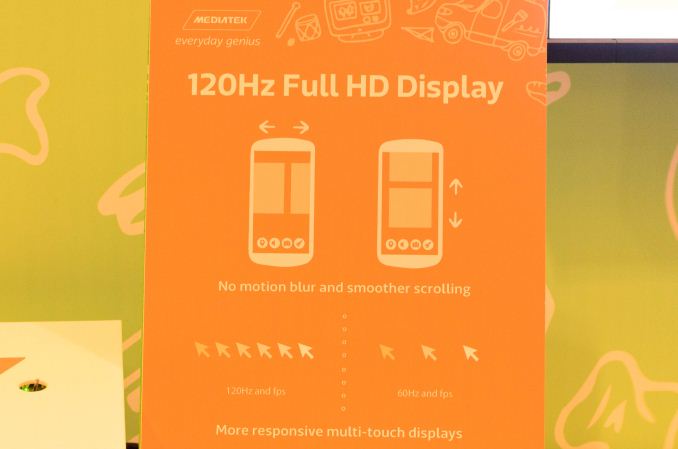MediaTek Demonstrates 120 Hz Mobile Display
by Joshua Ho & Brandon Chester on January 7, 2015 5:54 PM EST- Posted in
- Smartphones
- Mobile
- Tablets
- Trade Shows
- MediaTek
- CES 2015

While we often don’t deeply discuss MediaTek as a company, they are a major force in the mobile space. Their SoCs are widely used in the mid-range and budget segments of the mobile market, and they have widespread OEM adoption due to their turn-key reference designs. However, despite this mid-range positioning we saw an interesting demo of 120 Hz mobile displays at their CES press event, which can be seen below.
While the video is in slow motion to demonstrate the difference, in practice the benefit of the higher refresh rate is still quite visible. Text scrolling and motion was visibly clearer and more fluid, although it’s possible that displays with poor refresh rates wouldn’t see nearly as much benefit. MediaTek claims that this feature would increase display power consumption by about 10%, although it’s unclear whether this is with dynamic refresh rate adjustment or constant refresh rate. Features like this seem to be part of MediaTek’s new strategy of bringing value to the mid-range, and it will be interesting to see if MediaTek’s focus on Asia will continue to pay off.










31 Comments
View All Comments
markifi - Wednesday, January 7, 2015 - link
This has to reach market along with Google finally leaving triple frame buffering behind. 60hz is nice, but 120 with no buffering would be nice as an option.tuxfool - Wednesday, January 7, 2015 - link
It also appears to be a nice way to burn through power....Samus - Thursday, January 8, 2015 - link
If they'd stop trying to cram 400PPI+ into these things and prioritize actually important features like framerate and display quality, the whole battery power thing would be a wash. I'm sure a 200-250PPI 1080P display at 120hz saps the same amount of power as a 400PPI+ 1080P display at 60hz.rkhighlight - Thursday, January 8, 2015 - link
I don't know if you know what you're talking about. Two 1080p panels with different pixel density just means that the one with less PPI is bigger. A GPU doesn't care about PPI. 1080p means 1080p and it's always the same computational complexity.250 PPI + 1080p translate into a 8.8 inch panel.
400 PPI + 1080p translate into a 5.5 inch panel.
There's no other way (16:9 ratio presumed). Comparing the power draw if such different screen sizes doesn't make sense and the 8.8" display certainly uses more power with the same technology. No matter what refresh rate.
nikaldro - Thursday, January 8, 2015 - link
He's not totally wrong.A higher PPI count means that a stronger backlight is needed to achieve the same brightness
blanarahul - Friday, January 16, 2015 - link
I think I would like variable refresh rate much better than higher refresh rate, especially considering OLED panels have no lower limit on refresh rate. It would eliminate the need of Android trying to maintain 60 fps always and give the system some breathing room which, in theory, should improve both smoothness and overall power consumption.thetuna - Thursday, January 8, 2015 - link
I think what Samus was getting at is that as PPI increases, the percentage of space on the display taken up by light-blocking transistors grows; necessitating a more powerful backlight to get the same brightness.Although, I agree with you that the larger screen would most likely draw more power.
soccerballtux - Thursday, January 8, 2015 - link
if google would commit to requiring a solid 60hz for your app to be approved we wouldn't need this.Brandon Chester - Thursday, January 8, 2015 - link
They need to commit to having all of their own apps run at 60fps before they can expect developers to.Alexvrb - Thursday, January 8, 2015 - link
Even if that does happen it will only be on shiny new hardware. Then, when manufacturers feel that users need to be pushed towards newer hardware again, Google will update things and all of the new apps won't run smooth on your "old" hardware.